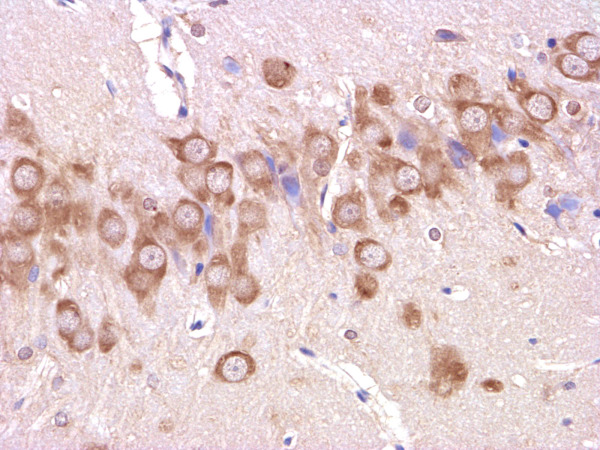
Immunohistochemistical detection of beta Amyloid using Anti-Beta Amyloid Antibody on TG APP23 mouse brain cortex frozen sections. Anti-Beta Amyloid Antibody used at 1/200 and incubated for 2 hours in TBS/BSA/Tween/azide. Fluorescent labelled anti rabbit IgG was then added.
beta Amyloid antibody
GTX82974
ApplicationsImmunoFluorescence, Western Blot, ELISA, ImmunoCytoChemistry, ImmunoHistoChemistry, ImmunoHistoChemistry Frozen, ImmunoHistoChemistry Paraffin
Product group Antibodies
ReactivityHuman, Mouse
TargetAPP
Overview
- SupplierGeneTex
- Product Namebeta Amyloid antibody
- Delivery Days Customer9
- Application Supplier NoteWB: 1:1000-1:5000. ICC/IF: 1:50-1:200. IHC-P: 1:50-1:200. IHC-Fr: 1:50-1:200. ELISA: 1:10000-1:30000. *Optimal dilutions/concentrations should be determined by the researcher.Not tested in other applications.
- ApplicationsImmunoFluorescence, Western Blot, ELISA, ImmunoCytoChemistry, ImmunoHistoChemistry, ImmunoHistoChemistry Frozen, ImmunoHistoChemistry Paraffin
- CertificationResearch Use Only
- ClonalityPolyclonal
- Concentration1.1 mg/ml
- ConjugateUnconjugated
- Gene ID351
- Target nameAPP
- Target descriptionamyloid beta precursor protein
- Target synonymsAAA, ABETA, ABPP, AD1, APPI, CTFgamma, CVAP, PN-II, PN2, alpha-sAPP, preA4, amyloid-beta precursor protein, alzheimer disease amyloid A4 protein homolog, alzheimer disease amyloid protein, amyloid beta (A4) precursor protein, amyloid beta A4 protein, amyloid precursor protein, beta-amyloid peptide, beta-amyloid peptide(1-40), beta-amyloid peptide(1-42), beta-amyloid precursor protein, cerebral vascular amyloid peptide, peptidase nexin-II, protease nexin-II, testicular tissue protein Li 2
- HostRabbit
- IsotypeIgG
- Protein IDP05067
- Protein NameAmyloid-beta precursor protein
- Scientific DescriptionBeta Amyloid, often abbreviated as A-beta, is a protein that builds up in the brains of persons with Alzheimers disease, collecting in clumps called plaques or senile plaques. While some researchers question whether Beta Amyloid is the cause of the dementia, most agree that it is involved in the disruption of thinking that is a hallmark of the disease. In some cases of familial Alzheimers disease, mutations in genes for the proteins called the presenilins lead to increased production of myloid. Researchers have been looking at how presenilin-1 in particular contributes to the excess buildup of Beta Amyloid. Presenilin-1 apparently acts to increase the activity of gamma-secretase, an enzyme that changes a normal protein (amyloid precursor protein or APP) into Beta Amyloid itself. Furthermore, presenilin-1 might be gamma-secretase.
- ReactivityHuman, Mouse
- Storage Instruction-20°C or -80°C,2°C to 8°C
- UNSPSC12352203















